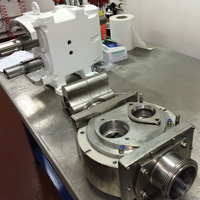 What Makes A Good Hygienic Pump Repairer?
What Makes A Good Hygienic Pump Repairer?
Tom Cooper of AxFlow looks at what it takes to be a good hygienic pump repairer
There are many pump repairers, fewer hygienic pump repairers and fewer still good hygienic pump repairers. This because it takes more than a clean bench and a box of antiseptic wipes to make a good hygienic pump repairer. To become a member of this select band of pump repairer requires a combination (Read More)
of three key attributes, namely: experience, knowledge and commitment.
Few things come easy in life and making a success of hygienic pump repair is no different. To do it well and avoid costly mistakes and multiple attempts at a repair you need experience of a wide variety of pump types, a good working knowledge of food and beverage manufacturing and the commitment to invest in both facilities and procedures. Taking a closer look at these areas we should first start with facilities.
Facilities
Advertisement - Hover to see more
As a bare minimum, you need a proper clean room curtained off from the rest of the workshop, dedicated hygienic tools stored correctly and a range of hygienic fittings for testing. Your test rig needs to be devoted to hygienic repairs, located in a hygienic area and have the ability to gas test pumps used, rather than water, whenever possible. You also need areas and equipment outside of the hygienic area, such as hygienic cleaning equipment, secure and sealed storage for the hygienic pump components and clean working areas for the non-hygienic parts such as motors, bearing housings etc. However, all the equipment in the world will do you little good without a well managed process (Fig.1) and well set out written procedures to ensure consistency of the process and that no rogue pumps slip through the net and back to the customer.
The process adopted at AxFlow is based on a few basic principles of separating the hygienic and unhygienic parts as soon as possible, then keeping them separate until the very last moment by using different equipment and areas (even within the main workshop), and using the hygienic area as little as possible limiting its use to the hygienic wet end final build and testing.
The importance of knowledge
Of course it’s not all about equipment and facilities; you also need a good working knowledge of a much wider range of pump types than many typical repairers will have. This is because food production involves a very broad number of pump types due to the diversity of physical properties displayed by the products being transferred. Food production can involve very high temperatures, light liquids such as oils, highly viscous products including starches and glucose, non-lubricating liquids, non-Newtonian liquids such as mayonnaise, shear sensitive products that can separate and finished products containing delicate solids.
Positive displacement pumps are very often the answer to these challenging liquids and consequently, a long list of these pumps are encountered within food processing plants. These include rotary lobe, circumferential piston, AOD (Fig.2), hose, progressive cavity, vane and eccentric rotating disc. And on top of these are the hygienically designed centrifugal pumps that are generally more sophisticated.
Positive displacement pumps are by their very nature much more challenging due to their tighter tolerances, less robust components and susceptibility to break. They can have very exacting performances particularly in the food industry, so the pump must be returned not just in working order, but demonstrating exactly the same performance as when it originally left the customer. To achieve this you require exactly the right components, work to high levels of precision and truly understand the pump. It also helps to know why the pump broke down in the first place, which is only possible by having a good practical knowledge of the pump and an understanding of the process in which it operated. This brings us on to the next important factor, experience of the food industry.
Experience
The food and beverage industry is extremely diverse when it comes to applications and it has become apparent to AxFlow as to just how important it is to have an appreciation of the food production processes. For example, it is very often the case that it is not just about getting a product from A to B, but ensuring that its consistency is not altered or that solids are not damaged. For this reason we make a point of recording the internal dimensions of all the pumps and then replicating these dimensions in the repaired pump using various methods that we have developed over many years.
This knowledge has led us, in many instances, to suggest making modifications to pumps and recommending ways of either running or setting up the pump in order to reduce problems. It is the in-depth knowledge of all pump types designed for hygienic applications, coupled with an understanding of food processing technologies that reassures our customers that they are safe in placing the repair of pumps for hygienic applications with AxFlow.
For further product details, contact:
AxFlow Ltd, Orion Park, Northfield Avenue, London, W13 9SJ
Tel: 020 8579 2111
Email: This email address is being protected from spambots. You need JavaScript enabled to view it.
www.axflow.co.uk



